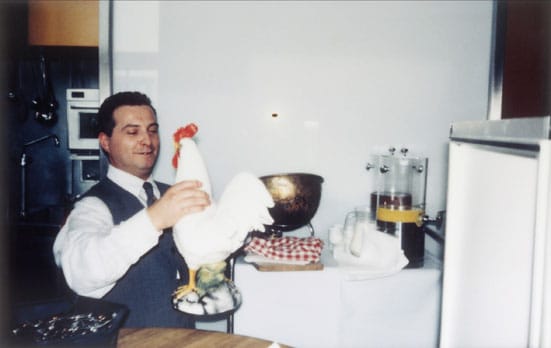20th April 2007 — 17th June 2007
Sometimes
it's as enlightening to watch the spectators as to watch the spectacle
itself. At many exhibitions you see a good deal of purposeful striding.
Not much of that here -- there is an awful lot of shuffling and poring,
though. The last time I saw this much poring was at a museum also
featuring a lot of small stuff, but that's where the similarity ends.
The museum was showing a glistering collection of Cartier jewellery,
but this gallery is showing garbage, mostly, as Joachim Schmid likes to
say. Until he got his hands on it.
Schmid's working philosophy over the last 25 years has been almost
totally confined to the appropriation and editing of other people's
images. He maintains he became disillusioned with actually taking
photos because his work didn't look any different to anyone else's.
Since then he has been devoted to unearthing, in compulsive-obsessive
style, all manner of illustrative material in junk shops, flea markets,
acquired from strangers' collections through acts of subterfuge, or
simply picked up in the street.
In a short video made by the gallery he throws down the
gauntlet, in the nicest possible way, declaring his disinterest in the
accepted genres of high street, commercial, art or fashion photography,
and his unhappiness at being described as an anthropologist, scientist,
or even an artist, proffering instead, 'Today's a beautiful day so
let's go out and do that.' It's a bit of a mouthful as job descriptions
go, but you can't help liking him for it. He then goes on to
display a lurid collection of ties and girlies in matching bikinis just
to contradict himself a bit. In
fact, his collectioneering has been pretty varied. He has not been
averse to drawing on the power of the already iconic with technicolor
John Waynes and Brigitte Bardots, in addition to making a point about a
glaring gap in history with contacts of Black Allied servicemen,
although they aren't in this retrospective. Visitors are presented with
an overwhelming hoard of material, far too much to absorb in a single
visit. Some of it IS rubbish, but you can't say he didn't warn us.
The sharpest set in the show again reveals the prankster in
Schmid. He placed an advert in a German newspaper claiming to be 'The
Institute for the Reprocessing of Used Photographs', explaining,
deadpan, the enormous dangers to health and children's morals posed by
abandoned and unfashionable photo collections. He invited people to
submit their unwanted material in order for them to be reprocessed or
ecologically disposed of free of charge. He was very nearly outpranked
by a commercial photographer who sent him a series of head and shoulder
shots,
vertically sliced in half to prevent their re-use. Schmid has reprinted
them by lining up complimenting halves to produce mismatching identikit
portraits that creep up on you unawares if you've left your glasses in
your other jacket. Perhaps unremarkably, the images that attract the
most attention are photo booth strips and snapshots. Scratched and
smeared, lost or discarded by their owners, and subsequently found by
Schmid. One, askew, shows a shop counter, souvenirs, the assistant's
bottom, and a clutch of photo packets - the last picture taken to use
up the end of the film, found in Berlin back in 2000 - end of an era?
There are 111others, mounted on off-white A4 cards pinned to the wall
in a long, long line, representing a tiny selection of an ongoing
compendium that might one day peter out due to digitalisation. The
Photographic Garbage Survey Project, we're told, takes the artist all
over the globe. He arrives at his destination and contrives an erratic
trajectory through the streets, picking up any photographic detritus he
sees, carefully logging his spoils on a map. Many of the photos are
found torn up, and he reassembles them.
Others still have pieces missing, and this seems to add to their
mystery.
They illustrate tiny, anonymous moments that were never
intended to be seen by the wider world, but since their abandonment
they have taken on a life of their own. They don't all hit the spot,
but Schmid's best discoveries are enigmatic enough for us to find
ourselves scouring the images for clues; giving them more time than we
would give to snaps in friend's photo albums, I fear.
PH
Photographers' Gallery
5 & 8 Great Newport Street
London WC2H 7H
http://www.photonet.org.uk
Open
Monday-Saturday, 11am-6pm
Thursday, 11am-8pm
Sunday, 12pm-6pm

Bilder Van Der Strasse
Ongoing since 1982
(c) Joachim Schmid